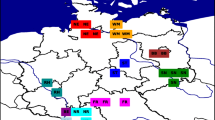Abstract
Rice blast, caused by Magnaporthe grisea does not occur in Australia. The potential for infection and sporulation events by M. grisea under Australian conditions was investigated using two software programs, DYMEX and CLIMEX. The climate of Deniliquin, NSW, representative of the southern Australian rice-growing areas, was projected to the rest of the world and compared, using CLIMEX, with foreign regions where rice blast occurs. Most of the locations whose climates matched that of Deniliquin were within the distribution range of rice blast and the potential for establishment of the disease therefore appears high. A model was also developed and run under DYMEX to predict the potential number of infection and sporulation events of the pathogen. The model was run for the period 1988–1999 with the meteorological data of four representative locations in the Australian ricegrowing region. Out of a possible 11 rice-growing seasons, the number of years favourable for M. grisea ranged from two at Griffith to nine at Yanco. The rice blast model confirmed the CLIMEX results and highlighted the potential threat of rice blast to the Australian rice industry. This paper reports the first disease model developed using DYMEX.
Similar content being viewed by others
References
Commonweath Mycological Institute (1981) Distribution maps of plant diseases No. 51 Pyricularia oryze Cav.’ (CAB International: Wallingford, UK)
Greer CA, Scardaci SC, Webster RK (1997) First report of rice blast caused by Magnaporthe grisea in California. Plant Disease 81, 1094.
Greer CA, Webster RK (2001) Occurrence, distribution, epidemiology, cultivar reaction, and management of rice blast disease in California. Plant Disease 85, 1096–1102.
Hashimoto A, Hirano K, Matsumoto K (1984) Studies on the forecasting of rice leaf blast development by application of the computer simulation. Special Bulletin of Fukushima Prefecture Agricultural Experiment Station 2, 1–104.
Hashioka Y (1965) Effects of environmental factors on development of causal fungus, infection, disease development, and epidemiology in rice blast disease. In ‘The rice blast disease’. pp. 153–161. (J Hopkins Press: Baltimore, USA)
Hemmi T, Imura J (1939) On the relation of air humidity to conidial formation in the rice blast fungus, Piricularia oryzae, and characteristics in the germination of conidia produced by the strains showing different pathogenicity. Annals of the Phytopathological Society of Japan 9, 147–156.
Julien MH, Skarratt B, Maywald GF (1995) Potential geographical distribution of alligator weed and its biological control by Agasicles hygrophila. Journal of Aquatic Management 33, 55–60.
Kato H, Kozaka T (1974) Effect of temperature on lesion enlargement and sporulation of Pyricularia oryzae in rice leaves. Phytopathology 64, 828–830.
Luo Y, Teng PS, Fabellar NG, TeBeest DO (1997) A rice leaf blast combined model for simulation of epidemics and yield loss. Agricultural Systems 53, 27–29.
Manibhushanrao K, Suryanarayanan S (1971) Isolation of an inositolless mutant of Pyricularia oryzae Cav. by ultraviolet irradiation. Phytophathology 72, 67–75.
Maywald GF, Sutherst RW, Zalucki MP (1997) Generic modelling for integrated pest management. In ‘Proceedings of MODSIM 97, international congress on modelling and simulation’. (Eds AD McDonald, M McAleer) pp. 1115–1116. (MODSIM æ97: Hobart, Australia)
Ou SH (1985) Blast. In ‘Rice diseases (2nd edn)’. (CAB International: Oxon, UK)
Park EW, Kim KR (1995) Rice blast forescasting system based on real time microclimatic data. Phytopathology 85, 1172.
Phillips D, Chandrashekar M, McLean G. (1992) Evaluation of potential disease and pest risk associated with paddy as a contaminant of milled rice imported into Australia. FAO Plant Protection Bulletin 40, 4–20.
Sutherst RW, Maywald GF (1985) A computerised system for matching climates in ecology. Agriculture Ecosystems and Environment 13, 281–299.
Sutherst RW, Maywald GF, Skarratt DB (1995) Predicting insect distributions in a changed climate. In ‘Insects in a changing environment’. (Eds R Harrington, NE Stork) pp. 59–91. (Academic Press: London)
Suzuki H (1975) Meteorological factors in the epidemiology of rice blast. Annual Review of Phytopathology 13, 239–256.
Venette RC, Hutchison WD (1999) Assessing the risk of establishment by pink bollworm (Lepidoptera gelechiidae) in the Southeastern United States. Environmental Entomology 28, 445–455.
Author information
Authors and Affiliations
Corresponding author
Rights and permissions
About this article
Cite this article
Lanoiselet, V., Cother, E.J. & Ash, G.J. CLIMEX and DYMEX simulations of the potential occurrence of rice blast disease in south-eastern Australia. Australasian Plant Pathology 31, 1–7 (2002). https://doi.org/10.1071/AP01070
Received:
Accepted:
Issue Date:
DOI: https://doi.org/10.1071/AP01070




